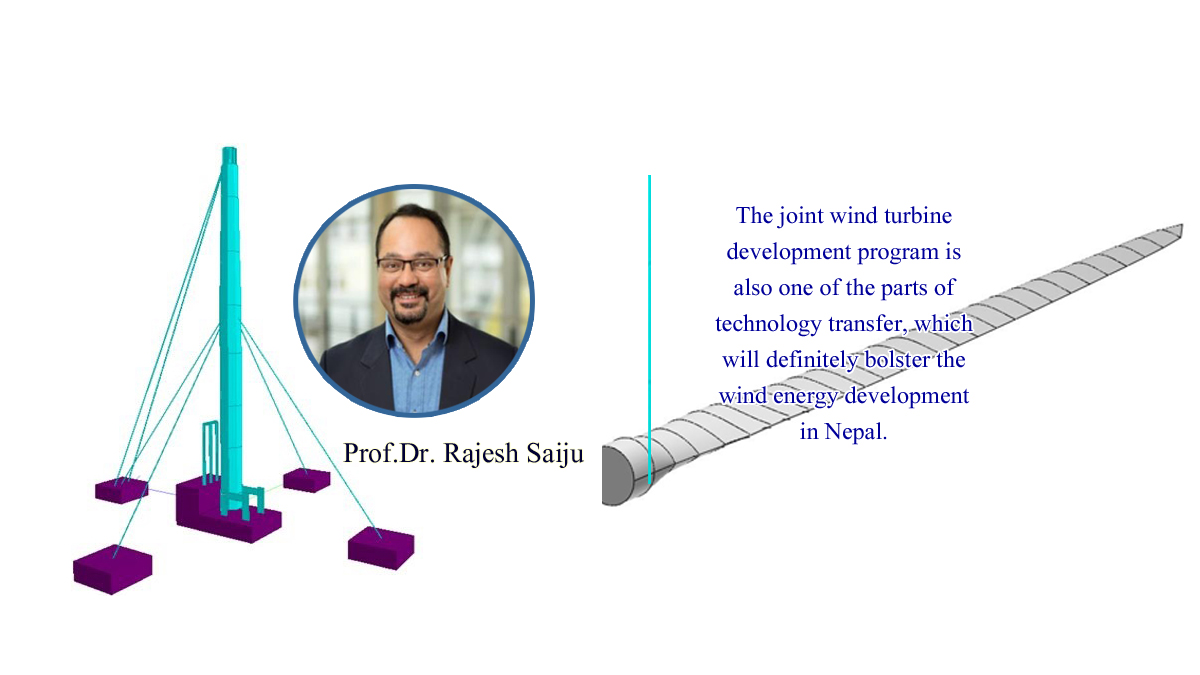
The global climate change resulting into the drastic average temperature increment year by year is one of the biggest problems which the earth and the human being will very seriously face in the coming decades, if we all do not collectively work against these changes, because we all are responsible for it. There might not be a big discussion in the scientific world that the global warming is directly related to the production of Carbon dioxide (CO2) through our energy consumption, which is based on the conventional energy sources –fossil fuels. The only way to come out from this problem to save the earth for coming generation is the production of electrical energy through the renewable energy sources like wind, solar, tide, biomass etc. The utilisation of such energy sources in developed countries are going rapidly forward but what is about the raising countries, developing countries. These countries also want to develop themselves also as the Europe and America and for that the energy hunger is rapidly increasing day by day. So, fossil fuels are being used as the primary energy sources, which definitely worsen our global problem.
Amongst other responsibilities the research and study works on the technologies of clean energy generation is an important responsibility, that’s why, we have been developing different types of wind turbines with our master students of wind energy since 2015. In every winter semester the students of third semester get this task of developing wind turbines in cooperation with different interested industry partners. In previous years, our development was focused on big wind turbines for European markets. Exceptional to those years, this year we are focusing our development based on medium size wind turbine for developing countries, which will work in extreme climate conditions, from low altitude to high altitude, huge temperature extremities etc. and the focused country is Nepal, where all climate zones from tropical to tundra is available. The geographical detail of Nepal is presented below in short.

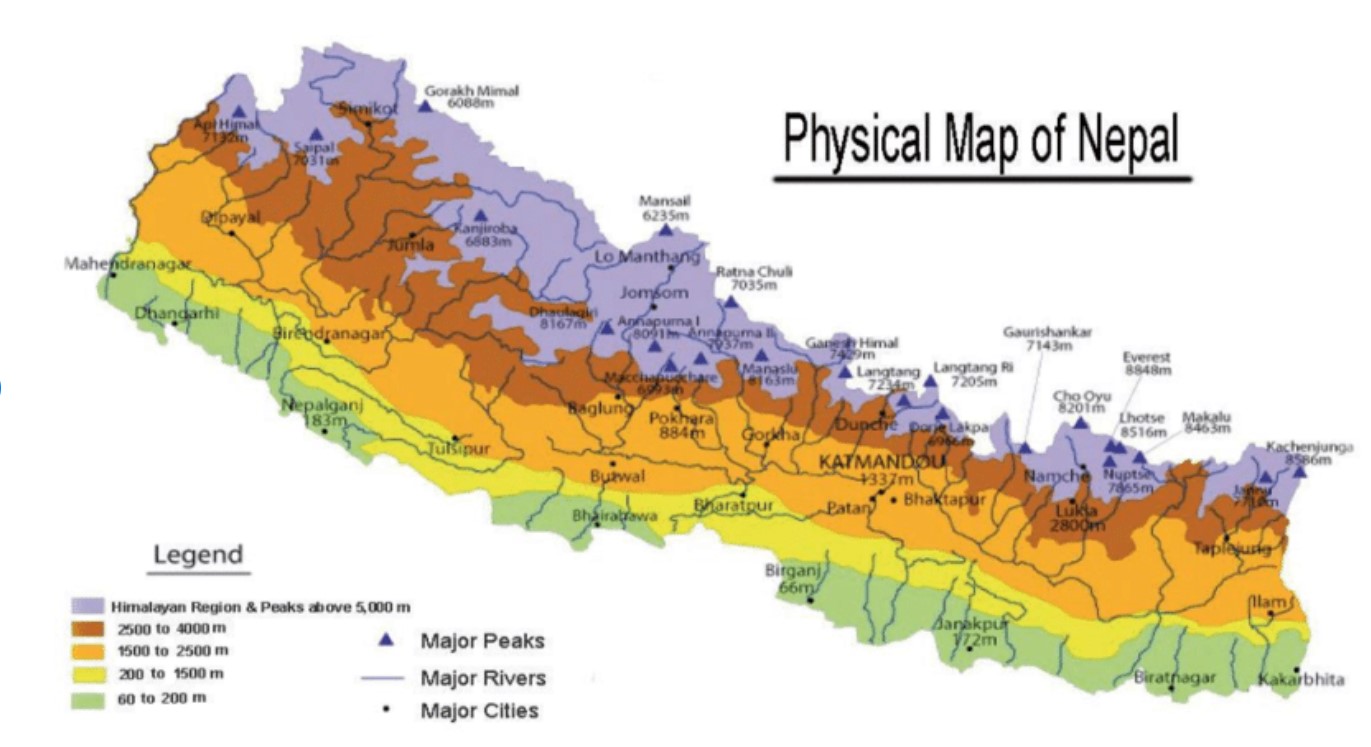 Figure 1: Physical map of Nepal [1]
Figure 1: Physical map of Nepal [1]
Nepal is a land locked country between India in south, east and west and China in north with 1,41,181 square Kilometre. It is around 850 km long from east to west and 190 km bright from south to north. Even though it is just 190 km wide, the landscape completely changes from south to north because of different altitudes, in south it is around 60 m from the sea level and in the north the big Himalayan ranges which include the highest mountain of the World Mount Everest (8848 m). Because of this Himalayan range Nepal has huge hydropower potential (85,000 MW capacities from that 45,000 MW is economically feasible). Because of this natural possibilities Nepal is using hydro power as main primary source for generating electrical energy. Most of the hydro power plants are run-off-river type, whose energy production fluctuates during summer and winter because of the variable water level in the rivers due to the monsoon period in the summer. After suffering from the load shedding for many years due to less generation of electrical power than demand, now Nepal is making good progress towards power independency based on hydro power. At the moment Nepal is producing around 1,700 MW electrical powers and in coming 5 years it will be increasing up to 3,500 MW. For the long term prosperity, definitely the generation of more and more hydro power, electrification of all sectors of life like transportation, house hold, Industries and export of electricity to the neighbouring countries are very important issues. But for the short term energy independency, Nepal has to boost the mix energy system for economical generation and transmission, security of energy supply which finally make possible to electrify all the parts of the social life and activities. It means, the grid based on different renewable energy sources as mentioned above. A mix energy system or hybrid power system could be in the fashion as shown below in figure 2, where different energy sources could be integrated, which makes grid more stable. The energy store system could be batteries, reservoirs are hydrogen plants.

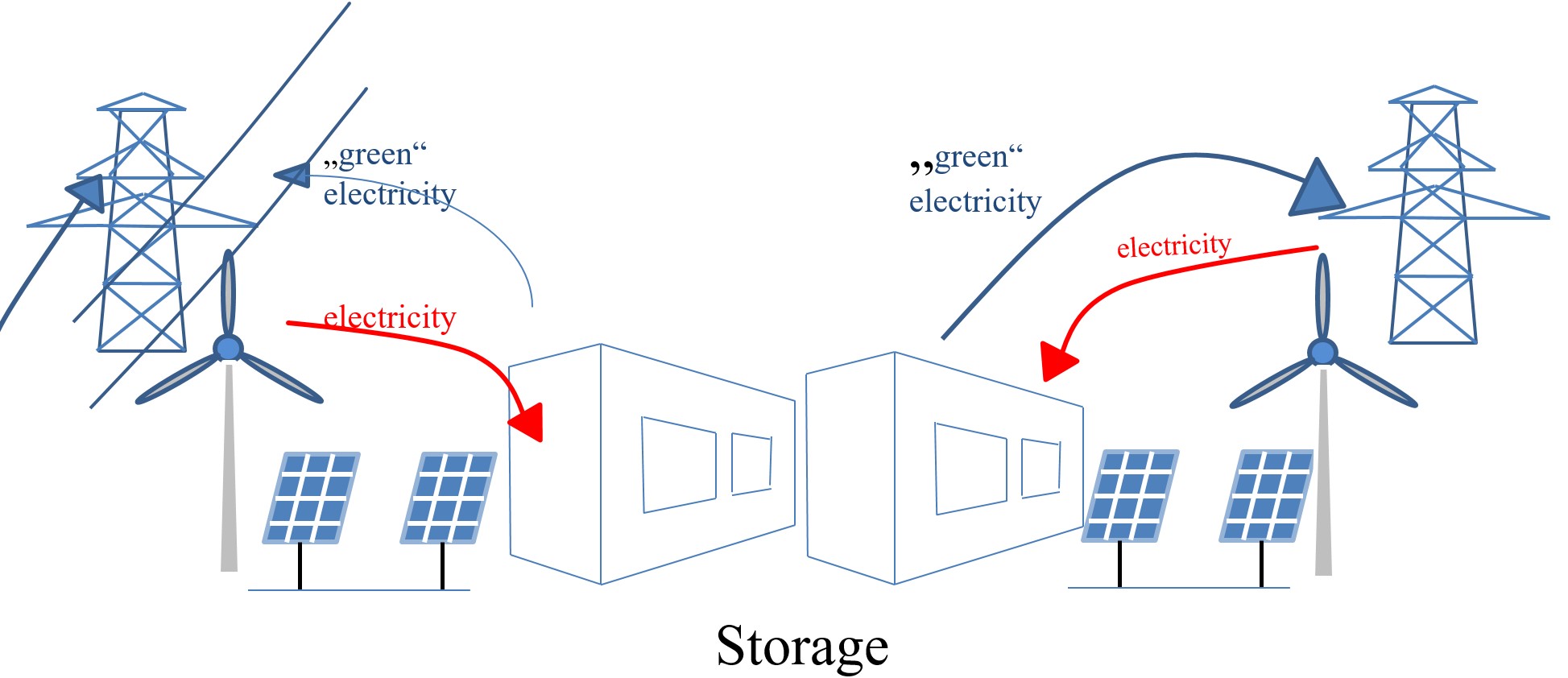 Figure 2: Hybrid power system concept
Figure 2: Hybrid power system concept
To introduce, to support, to boost this globally valuable and stabilised technology, WETI and UASK are developing a medium size wind turbine with Kathmandu University as an external partner and including involvement of 30 international master students. Here, it is also very important to mention that under the leadership of Prof. Rajesh Saiju in the year 2019 a Memorandum of Understanding [MoU] between UASF and KU has been signed. Based on this MoU the technology transfer, student exchange programs and professors exchange programs are going on. The joint wind turbine development program is also one of the parts of technology transfer, which will definitely bolster the wind energy development in Nepal.
Among many available and suitable sites based on many years of wind measurement data, the steering committee of professors and industry representative of different fields have chosen Kagbeni as the location of development because of the high altitude, weather extremities, transport complications, grid integration complexity etc. so that the students will come out with suitable technology, which will work in such complex geographical place. Hence such wind turbine could be installed and operated in many other similar developing countries in the world. The different possible locations and the wind velocities of Kagbeni is shown below in the figure 3.
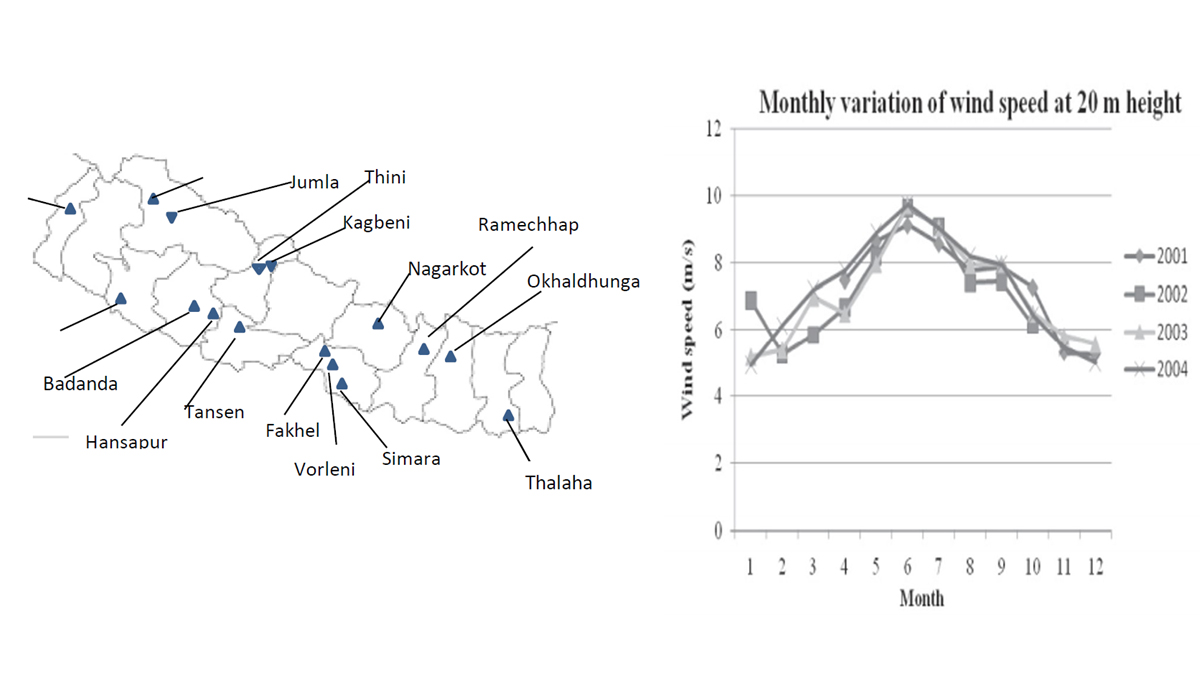 Figure 3: Possible wind power plant locations and wind speed map in Kagbeni [2]
Figure 3: Possible wind power plant locations and wind speed map in Kagbeni [2]
Because of the transport complexity, we choose the medium size wind turbine in the range of 800 kW which needs the blade radius of 29 m. The blade will be delivered in two pieces and connected in the location directly. Other important point is the tower which will be based on locally available timber, the environment friendly solution and positive contribution to the society. The development is also focusing on the utilisation of most closely available components to reduce transportation cost as well as CO2 production. Such wind towers will be a mile stone in the medium size wind turbines in developing countries. The intension is also to develop the timber rotor blades (figure 4).
The important technical data are presented in the table 1.
| Rated Power | 800 kW |
| Nominal Speed | 10m/s |
| Cut_In Speed | 3m/s |
| Cut_Out Speed | 25m/s |
| Rotor Diameter | 60m |
| Tower Height | 70m |
| Tower Material | Timber |
| Generator | Permanent Magnet Synchronous Generator |
| Speed_Max | 12m/s |
| Voltage | 690 V |
| Frequency | 50 Hz |
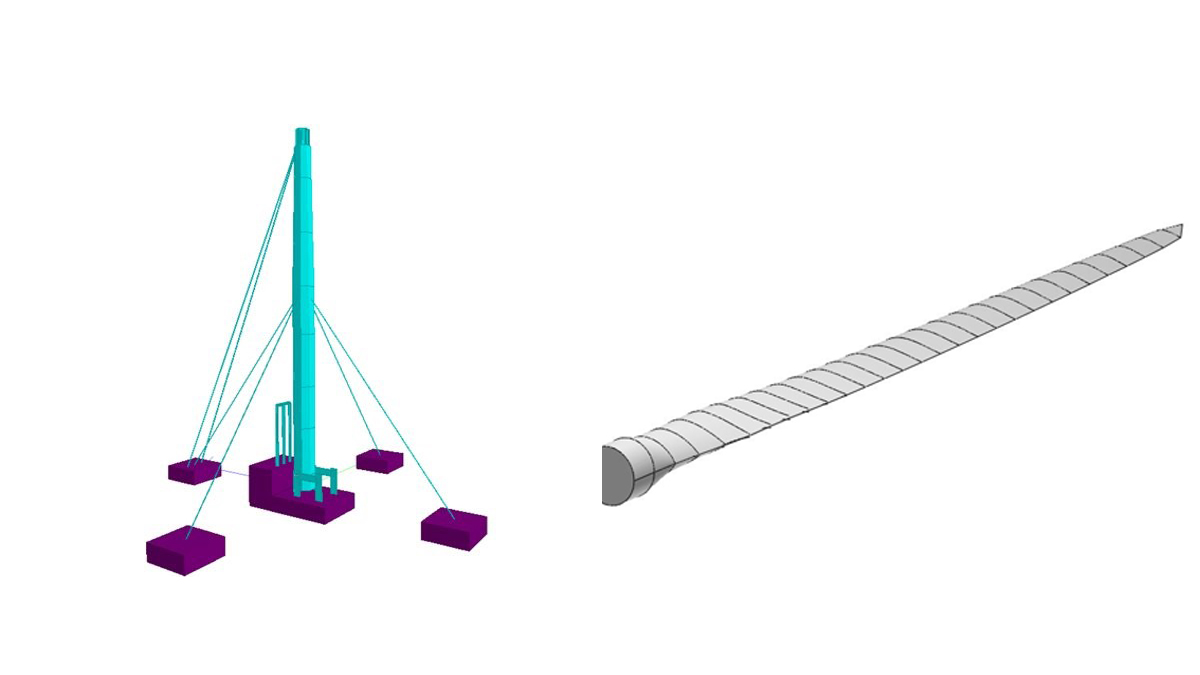 Figure4: Tower and blade of Optimus 60
Figure4: Tower and blade of Optimus 60
Grid Integration
In this development process, 800 kW wind turbine will be developed and 20 such wind turbines are used to build a wind park with total capacity of 16 MW, which will be connected to Dana Substation through a 132 kV Transmission line. The grid connection schematic with different voltage levels has been shown below.
Even though this project is at the moment bounded in the research work from the students, the future aim of this project is also to involve young students of Kathmandu University to lunch a prototype wind turbine in Kathmandu University and finally building a real wind turbine in Kagbeni location. Through such a project we hope, that we can contribute to educate students who further work on CO2 free energy systems in future.
The team of professors contributing in this project development are as follows:
Prof. Dr.-Ing. Toster Faber: Director of WETI (Civil Engineering, WETI)
Prof. Dr.-Ing. Toster Faber is the director of the Wind Energy Technology Institute (WETI) at Flensburg University of Applied Sciences (FUAS) since 2010. After an apprenticeship as a carpenter and studies in civil engineering at the Technical University of Hanover, Torsten Faber completed his doctorate at the Technical University of Hamburg-Harburg (TUHH) in the field of steel construction and timber construction. He worked 15 years in the industry and headed the department of rotor blades and civil engineering for the certification body, Germanischer Lloyd (GL). His main research interests and teaching activities are in the field of the building structure, support structure, life time analysis and certification of wind turbines.
Prof.Dipl.-Ing. Peter Quell: Project Supervisor (Mechanical Engineering, KUAS)
Peter Quell is professor at the Kiel University of Applied Sciences. He studied Mechanical Engineering at the Technical University of Berlin and started his career as development engineer at aerodyn Energiesysteme GmbH, an engineering office with focus on design of wind turbines. In pro+pro Energiesysteme and later Repower Systems AG he headed the R&D department and was responsible for the design of several commercial wind turbines in the multi-megawatt class.
In 2012 he became professor in Kiel. His main interests are in the field of wind turbine concepts for on- and offshore application as well as mechanical drivetrain solution.
Prof. Dr. Clemens Jauch (Grid Integration of renewable energies, WETI)
Clemens Jauch is research professor at the Wind Energy Technology Institute of Flensburg University of Applied Sciences. After completing an apprenticeship as car mechanic, he studied electrical power engineering at different universities in Germany, Norway and the UK. As R&D engineer he worked in the wind power industry and gained his PhD degree at Aalborg University in Denmark. Further work experience in Australia and Germany then lead to the professorship, where he has been researching and teaching on grid integration of wind power, control of wind turbines for grid support, and kinetic energy storage since 2012.
Prof. Dr.-Ing. David Schlif (Control Systems, WETI)
David Schlipf received his PhD entitled "Lidar-Assisted Control Concepts for Wind Turbines" from the University of Stuttgart. After his PhD he was a research scholar at the University of Colorado Boulder and NREL, carrying out research related to lidars and floating wind turbines. In 2016 he founded sowento, a startup company for renewable energy control. Since 2018 he is a research professor at the Flensburg University of Applied Sciences focusing his research and teaching activities on wind turbine control and lidar data processing. He is operating the IEA Wind Task 32 on Lidar, is the treasurer of the European Academy of Wind Energy, and an editor of the Wind Energy Journal.
Prof. Dr.-Ing. Peter Schaffarzyk (Aerodynamics Engineering, KUAS)
Alois Peter Schaffarczyk was educated as an Applied Theoretical Physicist and received his PhD from University of Goettingen, Germany.
After some inspiring years in industry as Software and Research Engineer, focussing on Computational Fluid Mechanics (CFD), his became Professor for Mathematics and Engineering Mechanics at Kiel University of Applied Sciences, Kiel. Germany. Since a lot a years he is working on experimental and theoretical wind turbine aerodynamics. He edited and published several text books and many articles.
Dipl.-Ing. Andreas Manjok (Load Calculation, DNV)
Prof.Dr. Er. Biraj Singh Thapa (Mechanical Engineering, KU)
Dr. Biraj Singh Thapa is Assistant Professor at Department of Mechanical Engineering, KU. His area of specialization are hydropower and green hydrogen. He believes that a strategic blend of these two energy sectors would develop an energy ecosystem for the transition towards a low carbon society in. He has been leading several projects to implement hydropower as the means for introducing green hydrogen as an alternative future fuel in Nepal and serves as the Team Leader of the Green Hydrogen Lab at Kathmandu University. He holds a Ph.D. degree from the Norwegian University of Science and Technology (NTNU), Norway.
Last but not least, as a part of this steering committee I would like to thank all the involved groups of Students and Professors.
References:
1. Source: Physical map of Nepal | Download Scientific Diagram (researchgate.net))
2. Wind Energy Resource Assessment and Feasibility Study of Wind Farm in Kaligandaki Riverbank of Mustang District, M. Ghimire, R.C. Poudel, Nepal Journal of Science and Technology 11 (2010) 159-166
(Mr. Sainju is associated with the Flensburg University of Applied Sciences situated in the city of Flensburg, Germany and working in the department of Energy and Biotechnology. He is researching and teaching in the field of electrical power systems with key specialisation in renewable energy sources and hybrid power systems. He has obtained his PhD from University of Kassel in the field of Hybrid Power System and Energy Management. After pursuing the PhD degree, Rajesh Saiju gained industrial experiences in different company in Germany like Voith Hydro GmbH & Co.KG as a research engineer and Nordex Energy & SE Co.KG as a project manager for more than 7 years, before that he had four years of work experience in hydro power sector with Himal power limited (Khimti Hydro Power) and since 2015 he is professor)

Mr. Sainju is associated with the Flensburg University of Applied Sciences situated in the city of Flensburg, Germany and working in the department of Energy and Biotechnology. He is researching and teaching in the field of electrical power systems with key specialisation in renewable energy sources and hybrid power systems. He has obtained his PhD from University of Kassel in the field of Hybrid Power System and Energy Management. After pursuing the PhD degree, Rajesh Saiju gained industrial experiences in different company in Germany like Voith Hydro GmbH & Co.KG as a research engineer and Nordex Energy & SE Co.KG as a project manager for more than 7 years, before that he had four years of work experience in hydro power sector with Himal power limited (Khimti Hydro Power) and since 2015 he is professor